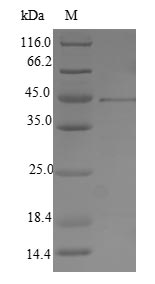Unlock the potential of virology research with our Recombinant Human herpesvirus 2 Envelope glycoprotein B, an essential protein for understanding the viral fusion process and immune evasion mechanisms in Human herpesvirus 2 (HHV-2) infections. Envelope glycoprotein B, encoded by the gB (UL27) gene, plays a critical role in the Human herpesvirus 2 (strain HG52) life cycle, particularly in viral entry and cell fusion events.
Our Recombinant Human herpesvirus 2 Envelope glycoprotein B is produced in E.coli expression systems, representing a partial length of the protein, covering the 23-279 amino acid expression region. This protein is equipped with an N-terminal 6xHis-SUMO tag, facilitating effective purification and detection processes. With a purity greater than 90% as determined by SDS-PAGE, our recombinant protein ensures reliability and reproducibility in your experiments. The product is available in liquid or lyophilized powder form, providing adaptability for various research applications.






